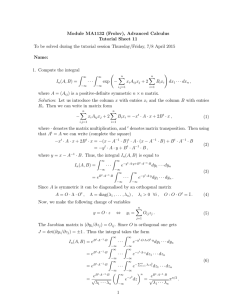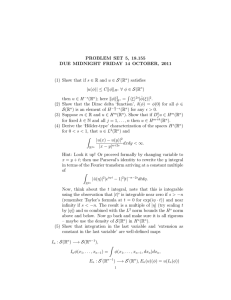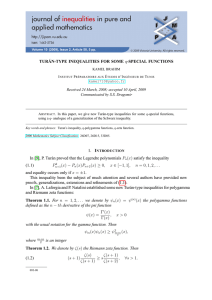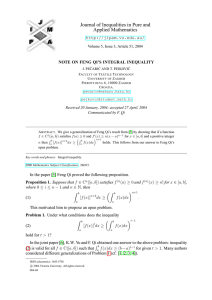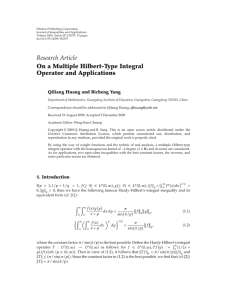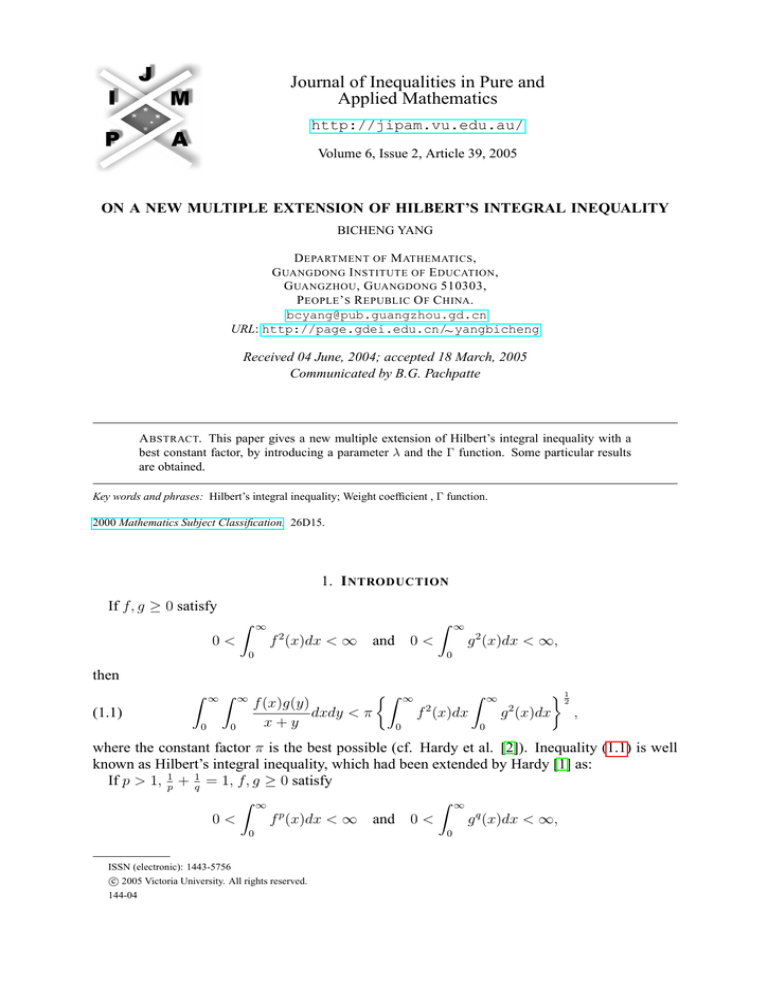
Journal of Inequalities in Pure and
Applied Mathematics
http://jipam.vu.edu.au/
Volume 6, Issue 2, Article 39, 2005
ON A NEW MULTIPLE EXTENSION OF HILBERT’S INTEGRAL INEQUALITY
BICHENG YANG
D EPARTMENT OF M ATHEMATICS ,
G UANGDONG I NSTITUTE OF E DUCATION ,
G UANGZHOU , G UANGDONG 510303,
P EOPLE ’ S R EPUBLIC O F C HINA .
bcyang@pub.guangzhou.gd.cn
URL: http://page.gdei.edu.cn/~ yangbicheng
Received 04 June, 2004; accepted 18 March, 2005
Communicated by B.G. Pachpatte
A BSTRACT. This paper gives a new multiple extension of Hilbert’s integral inequality with a
best constant factor, by introducing a parameter λ and the Γ function. Some particular results
are obtained.
Key words and phrases: Hilbert’s integral inequality; Weight coefficient , Γ function.
2000 Mathematics Subject Classification. 26D15.
1. I NTRODUCTION
If f, g ≥ 0 satisfy
∞
Z
2
f (x)dx < ∞
0<
∞
Z
g 2 (x)dx < ∞,
0<
and
0
0
then
Z
∞
Z
(1.1)
0
0
∞
f (x)g(y)
dxdy < π
x+y
Z
∞
Z
2
f (x)dx
0
∞
2
g (x)dx
12
,
0
where the constant factor π is the best possible (cf. Hardy et al. [2]). Inequality (1.1) is well
known as Hilbert’s integral inequality, which had been extended by Hardy [1] as:
If p > 1, p1 + 1q = 1, f, g ≥ 0 satisfy
Z ∞
Z ∞
p
0<
f (x)dx < ∞ and 0 <
g q (x)dx < ∞,
0
ISSN (electronic): 1443-5756
c 2005 Victoria University. All rights reserved.
144-04
0
2
B ICHENG YANG
then
∞
Z
∞
Z
(1.2)
0
0
f (x)g(y)
π
dxdy <
x+y
sin πp
Z
p1 Z
∞
p
f (x)dx
0
∞
q
g (x)dx
1q
,
0
π
where the constant factor sin(π/p)
is the best possible. Inequality (1.2) is called Hardy- Hilbert’s
integral inequality, and is important in analysis and its applications (cf. Mitrinović et al.[6]).
Recently, by introducing a parameter λ, Yang [9] gave an extension of (1.2) as:
If λ > 2 − min{p, q}, f, g ≥ 0 satisfy
Z ∞
Z ∞
1−λ p
0<
x f (x)dx < ∞ and 0 <
x1−λ g q (x)dx < ∞,
0
0
then
Z ∞
p1 Z ∞
1q
f (x)g(y)
1−λ p
1−λ q
dxdy < kλ (p)
x f (x)dx
x g (x)dx ,
(1.3)
(x + y)λ
0
0
0
0
q+λ−2
where the constant factor kλ (p) = B p+λ−2
,
is the best possible (B(u, v) is the β
p
q
function). For λ = 1, inequality (1.3) reduces to (1.2).
On the problem for multiple extension of (1.1), [3, 4] gave some new results and Yang [8]
gave an improvement of their
as:
Pn works
1
If n ∈ N\{1}, pi > 1, i=1 pi = 1, λ > n − min {pi }, fi ≥ 0, satisfy
1≤i≤n
Z ∞
0<
xn−1−λ fipi (x)dx < ∞ (i = 1, 2, . . . , n),
Z
∞
Z
∞
0
then
Z
∞
Z
∞
···
(1.4)
0
P
n
j=1
0
n
Y
1
xj
λ
fi (xi )dx1 . . . dxn
i=1
Z ∞
p1
n
i
1 Y
pi + λ − n
n−1−λ pi
<
Γ
x
fi (x)dx
,
Γ(λ) i=1
pi
0
Qn
pi +λ−n
1
where the constant factor Γ(λ)
Γ
is the best possible. For n = 2, inequality (1.4)
i=1
pi
reduces to (1.3). It follows that (1.4) is a multiple extension of (1.3), (1.2) and (1.1).
In 2003, Yang et. al [11] provided an extensive account of the above results.
The main objective of this paper is to build a new extension of (1.1) with a best constant
factor other than (1.4), and give some new particular results. That is
P
Theorem 1.1. If n ∈ N\{1}, pi > 1, ni=1 p1i = 1, λ > 0, fi ≥ 0, satisfy
Z ∞
0<
xpi −1−λ fipi (x)dx < ∞ (i = 1, 2, . . . , n),
0
then
Z
∞
Z
···
(1.5)
0
0
∞
n
Y
1
P
n
j=1
xj
λ
fi (xi )dx1 . . . dxn
i=1
n
1 Y
<
Γ
Γ(λ) i=1
J. Inequal. Pure and Appl. Math., 6(2) Art. 39, 2005
Z ∞
p1
i
λ
pi −1−λ pi
x
fi (x)dx
,
pi
0
http://jipam.vu.edu.au/
O N A N EW M ULTIPLE E XTENSION OF H ILBERT ’ S I NTEGRAL I NEQUALITY
where the constant factor
1
Γ(λ)
Qn
i=1 Γ
λ
pi
3
is the best possible. In particular,
(a) for λ = 1, we have
Z ∞
p1
Z ∞
Z ∞ Qn
n
Y
i
fi (xi )
1
pi −2 pi
i=1
Pn
(1.6)
···
dx1 . . . dxn <
Γ
x
fi (x)dx
;
pi
0
0
0
j=1 xj
i=1
(b) for n = 2, using the symbol of (1.3) and setting e
kλ (p) = B λp , λq , we have
∞
Z
∞
Z
(1.7)
0
0
f (x)g(y)
dxdy < e
kλ (p)
(x + y)λ
∞
Z
x
p−1−λ p
p1 Z
x
f (x)dx
0
∞
q−1−λ q
1q
g (x)dx
,
0
where the constant factors in (1.6) and (1.7) are still the best possible.
In order to prove the theorem, we introduce some lemmas.
2. S OME L EMMAS
P
Lemma 2.1. If k ∈ N, ri > 1 (i = 1, 2, . . . , k + 1), and k+1
i=1 ri = λ(k), then
Qk+1
Z ∞
Z ∞
k
Y
Γ(ri )
1
rj −1
(2.1)
···
.
uj du1 . . . duk = i=1
λ(k)
P
Γ(λ(k))
k
0
0
j=1
1 + j=1 uj
Proof. We establish (2.1) by mathematical induction. For k = 1, since r1 + r2 = λ(1), and (see
[7])
Z ∞
up−1
(2.2)
B(p, q) =
du = B(q, p)
(p, q > 0),
(1 + u)p+q
0
P
we have (2.1). Suppose for .
k ∈ N, that (2.1)
is valid. Then for k + 1, since r1 + k+1
i=2 ri =
Pk+1
λ(k + 1), by setting v = u1
1 + j=2 uj , we obtain
Z
∞
∞
Z
···
(2.3)
0
0
Z
1+
∞
Z
Pk+1
j=1
∞
···
=
0
Z
0
∞
Z
···
=
k+1
Y
1
0
0
∞
λ(k+1)
uj
r −1
uj j
du1 . . . duk+1
j=1
r1 Q
P
k+1 rj −1
v r1 −1 1 + k+1
u
j=2 j
j=2 uj
dvdu2 . . . duk+1
Pk+1 λ(k+1)
λ(k+1)
1 + j=2 uj
(1 + v)
Qk+1 rj −1
Z ∞
v r1 −1
j=2 uj
du
.
.
.
du
dv.
k+1
Pk+1 λ(k+1)−r1 2
(1 + v)λ(k+1)
0
1 + j=2 uj
In view of (2.2) and the assumption of k, we have
!
Z ∞
k+1
X
v r1 −1
1
(2.4)
dv =
Γ
ri Γ(r1 );
(1 + v)λ(k+1)
Γ(λ(k + 1))
0
i=2
Z
∞
Z
···
(2.5)
0
0
∞
Qk+2
r −1
uj j
Γ(ri )
.
du2 . . . duk+1 = i=2
P
λ(k+1)−r
1
Pk+1
k+1
Γ
r
1 + j=2 uj
i=2 i
Qk+1
j=2
J. Inequal. Pure and Appl. Math., 6(2) Art. 39, 2005
http://jipam.vu.edu.au/
4
B ICHENG YANG
Then, by (2.5), (2.4) and (2.3), we find
Qk+1 rj −1
Qk+2
Z ∞
Z ∞
j=1 uj
i=1 Γ(ri )
.
···
λ(k+1) du1 . . . duk+1 =
P
Γ(λ(k + 1))
0
0
1 + k+1
u
j=1 j
Hence (2.1) is valid for k ∈ N by induction. The lemma is proved.
Pn 1
Lemma 2.2. If n ∈ N\{1}, pi > 1 (i = 1, 2, . . . , n), i=1 pi = 1 and λ > 0, set the weight
coefficient ω(xi ) as
(λ−pj )/pj
Z ∞ Qn
λ Z ∞
pj
j=1(j6=i) xj
(2.6)
ω(xi ) := xi
···
dx1 . . . dxi−1 dxi+1 . . . dxn .
P
λ
n
0
0
j=1 xj
Then, each ω(xi ) is constant, that is
n
(2.7)
1 Y
ω(xi ) =
Γ
Γ(λ) j=1
λ
pj
,
(i = 1, 2, . . . , n).
Proof. Fix i. Setting pen = pi , and pej = pj , uj = xj /xi , for j = 1, 2, . . . , i − 1; pej = pj+1 , uj =
xj+1 /xi , for j = i, i + 1, . . . , n − 1 in (2.6), by simplification, we have
Z ∞
Z ∞
n−1
Y −1+ pλ
1
j
(2.8)
ω(xi ) =
···
uj
du1 . . . dun−1 .
λ
P
n−1
0
0
1 + j=1 uj j=1
Substitution of n − 1 for k, λ for λ(k) and λ/pej for rj (j = 1, 2, . . . , n) into (2.1), in view of
(2.8), we have
n
n
λ
1 Y
λ
1 Y
ω(xi ) =
Γ
=
Γ
.
Γ(λ) j=1
pej
Γ(λ) j=1
pj
Hence, (2.7) is valid. The lemma is proved.
Lemma 2.3. As in the assumption of Lemma 2.2, for 0 < ε < λ, we have
Z ∞
Z ∞ Qn (λ−pi −ε)/pi
i=1 xi
I := ε
···
P
λ dx1 . . . dxn
n
1
1
x
j=1 j
n
1 Y
λ
(2.9)
≥
Γ
(ε → 0+ ).
Γ(λ) i=1
pi
Proof. Setting ui = xi /xn (i = 1, 2, . . . , n − 1) in the following, we find
Z ∞
Z ∞
Z ∞ Qn−1 (λ−pi −ε)/pi
i=1 ui
···
I=ε
x−1−ε
λ du1 . . . dun−1 dxn
n
P
−1
−1
1
xn
xn
1 + n−1
j=1 uj
Z ∞
Z ∞
Z ∞ Qn−1 (λ−pi −ε)/pi
i=1 ui
≥ε
x−1−ε
···
λ du1 . . . dun−1 dxn
n
P
1
0
0
1 + n−1
j=1 uj
Z ∞
n−1
X
−1
(2.10)
−ε
xn
Aj (xn )dxn ,
1
J. Inequal. Pure and Appl. Math., 6(2) Art. 39, 2005
j=1
http://jipam.vu.edu.au/
O N A N EW M ULTIPLE E XTENSION OF H ILBERT ’ S I NTEGRAL I NEQUALITY
5
where, for j = 1, 2, . . . , n − 1, Aj (xn ) is defined by
Z
i=1
···
Aj (xn ) :=
(2.11)
Qn−1
Z
(1 +
Dj
(λ−p −ε)/pi
ui i
Pn−1
j=1
uj )λ
du1 . . . dun−1 ,
satisfying Dj = {(u1 , u2 , . . . , un−1 )|0 < uj ≤ x−1
n , 0 < uk < ∞ (k 6= j)}.
Without loss of generality, we estimate the integral Aj (xn ) for j = 1.
(a) For n = 2, we have
x−1
n
Z
1
(λ−p −ε)/p1
u1 1
du1
λ
(1 + u1 )
A1 (xn ) =
0
Z
x−1
n
≤
(λ−p1 −ε)/p1
u1
du1 =
0
p1 −(λ−ε)/p1
x
;
λ−ε n
(b) For n ∈ N\{1, 2}, by (2.1), we have
∞
Z
A1 (xn ) ≤
Z
···
0
0
− λ−ε
p 1 x n p1
≤
λ−ε
=
∞
Z
Qn−1
∞
i=2
···
0
− λ−ε
p 1 x n p1
λ−ε
i
i=2 ui
Pn−1 λ du1 . . . dun−1
1 + j=2 uj
∞
Z
−1+ λ−ε
p
Qn−1
Qn
·
0
i=2
1+
j=2
Γ( λ−ε
)
pi
Γ((λ − ε)(1 − p−1
1 ))
λ−p1 −ε
p1
u1
du1
0
−1+(λ−ε)/pi
ui
Pn−1
x−1
n
Z
uj
du1 . . . dun−1
(λ−ε)(1−p−1
1 )
.
By virtue of the results of (a) and (b), for j = 1, 2, . . . , n − 1,we have
Aj (xn ) ≤
(2.12)
pj −(λ−ε)/pj
x
Oj (1)
λ−ε n
(ε → 0+ , n ∈ N\{1}).
By (2.11), since for ε → 0+ ,
Z
∞
···
0
Z
1
−1+(λ−ε)/pi
∞
i=1 ui
Pn−1 λ du1
0
1 + j=1 uj
Z
∞
x−1
n
Qn
Qn−1
n−1
X
Aj (xn )dxn =
j=1
. . . dun−1 =
n−1 Z
X
j=1
i=1
Γ
Γ(λ)
λ
pi
+ o(1);
∞
x−1
n Aj (xn )dxn
1
Z ∞
n−1
X
pj
j
Oj (1)
x−1−(λ−ε)/p
dxn
≤
n
λ
−
ε
1
j=1
2
n−1 X
pj
=
Oj (1),
λ−ε
j=1
J. Inequal. Pure and Appl. Math., 6(2) Art. 39, 2005
http://jipam.vu.edu.au/
6
B ICHENG YANG
then by (2.10) , we find
Qn
i=1
I≥
→
Γ
λ
pi
Γ(λ)
Qn
λ
Γ
i=1
pi
2
n−1 X
p
j
Oj (1)
+ o(1) − ε
λ−ε
j=1
(ε → 0+ ).
Γ(λ)
Thereby, (2.9) is valid and the lemma is proved.
3. P ROOF OF THE T HEOREM
AND
R EMARKS
Proof of Theorem 1.1. By Hölder’s inequality, we have
Z ∞
Z ∞
n
Y
1
fi (xi )dx1 . . . dxn
J :=
···
P
λ
n
0
0
i=1
x
j=1 j
p1
i
Z ∞
Z ∞
λ−pj
n
n
Y
Y
(pi −λ)(1−p−1 )
fi (xi )
pj
i
=
···
x
x
P
λ/pi i
j
dx1 . . . dxn
n
0
0
j=1
i=1
j=1 xj
(j6=i)
(3.1)
≤
Z
n
Y
i=1
∞
Z
∞
···
0
0
1
pi
λ−pj
n
Y
fipi (xi )
p
(pi −λ)(1−p−1
i )
xj j dx1 . . . dxn
.
P
λ x i
n
j=1
x
j=1 j
(j6=i)
If (3.1) takes the form of equality, then there exists constants C1 , C2 , . . . , Cn , such that they are
not all zero and for any i 6= k ∈ {1, 2, . . . , n} (see [5]),
(pi −λ)(1−p−1
i )
fipi (xi )xi
Ci
P
n
j=1 xj
(3.2)
n
Y
λ
λ−pj
pj
xj
j=1
(p −λ)(1−p−1
k )
fkpk (xk )xk k
= Ck
P
n
j=1 xj
(j6=i)
n
Y
λ
λ−pj
pj
xj
,
j=1
(j6=k)
a.e. in (0, ∞) × · · · × (0, ∞).
Assume that Ci 6= 0. By simplification of (3.2), we find
xipi −λ fipi (xi ) = F (x1 , . . . , xi−1 , xi+1 , . . . , xn )
= constant a.e. in (0, ∞) × · · · × (0, ∞),
R∞
which contradicts the fact that 0 < 0 xipi −λ−1 fipi (x)dx < ∞. Hence by (2.6) and (3.1), we
conclude
p1
n Z ∞
Y
i
pi −1−λ pi
.
(3.3)
J<
ω(xi )xi
fi (xi )dxi
i=1
0
Then by (2.7), we have (1.5).
For 0 < ε < λ, setting fei (xi ) as: fei (xi ) = 0, for xi ∈ (0, 1);
(λ−p −ε)/pi
fei (xi ) = xi i
,
J. Inequal. Pure and Appl. Math., 6(2) Art. 39, 2005
for xi ∈ [1, ∞) (i = 1, 2, . . . , n),
http://jipam.vu.edu.au/
O N A N EW M ULTIPLE E XTENSION OF H ILBERT ’ S I NTEGRAL I NEQUALITY
7
then we find
ε
(3.4)
n Z
Y
0
0
∞
n
Y
1
P
n
j=1
xpi i −1−λ feipi (xi )dxi
p1
i
= 1.
0
i=1
By (2.9), we find
Z ∞
Z
(3.5)
ε
···
∞
xj
λ
fei (xi )dx1 . . . dxn
i=1
n
1 Y
=I≥
Γ
Γ(λ) i=1
λ
pi
(ε → 0+ ).
Qn
1
λ
If the constant factor Γ(λ)
Γ
in (1.5) is not the best possible, then there exists a posii=1
pi
Q
Qn
n
1
λ
1
tive constant K < Γ(λ) i=1 Γ pi , such that (1.5) is still valid if one replaces Γ(λ) i=1 Γ pλi
by K. In particular, one has
p1
Z ∞
Z ∞
n
n Z ∞
Y
Y
i
1
p
p
−1−λ
i
i
ε
···
fei (xi )dx1 . . . dxn < εK
x
fei (x)dx
,
P
λ
n
0
0
0
i=1
i=1
j=1 xj
Qn
1
λ
and in view of (3.4) and (3.5), it follows that Γ(λ)
Γ
≤ K (ε → 0+ ). This contradicts
i=1
pi
Qn
Qn
1
λ
1
the fact K < Γ(λ) i=1 Γ pi . Hence the constant factor Γ(λ) i=1 Γ pλi in (1.5) is the best
possible.
The theorem is proved.
Remark 3.1. For λ = 1, inequality (1.7) reduces to (see [10])
Z ∞
p1 Z ∞
1q
Z ∞Z ∞
f (x)g(y)
π
p−2 p
q−2 q
(3.6)
dxdy <
x f (x)dx
x g (x)dx .
x+y
0
0
0
0
sin πp
For p = q = 2, both (3.6) and (1.2) reduce to (1.1). It follows that inequalities (3.6) and (1.2)
are different extensions of (1.1). Hence, inequality (1.5) is a new multiple extension of (1.1).
Since all the constant factors in the obtained inequalities are the best possible, we have obtained
new results.
R EFERENCES
[1] G.H. HARDY, Note on a theorem of Hilbert concerning series of positive terms, Proc. Math. Soc.,
23(2) (1925), Records of Proc. XLV-XLVI.
[2] G.H. HARDY, J.E. LITTLEWOOD
Cambridge, 1952.
AND
G. POLYA, Inequalities, Cambridge University Press,
[3] YONG HONG, All-sided generalization about Hardy-Hilbert’s integral inequalities, Acta Math.
Sinica, 44(4) (2001), 619–626.
[4] LEPING HE, JIANGMING YU AND MINGZHE GAO, An extension of Hilbert’s integral inequality, J. Shaoguan University (Natural Science), 23(3) (YEAR), 25–29.
[5] JICHANG KUANG, Applied Inequalities, Hunan Education Press, Changsha, 2004.
[6] D.S. MITRINOVIĆ, J.E. PEČARIĆ AND A.M. FINK, Inequalities Involving Functions and Their
Integrals and Derivatives, Kluwer Academic Publishers, Boston, 1991.
J. Inequal. Pure and Appl. Math., 6(2) Art. 39, 2005
http://jipam.vu.edu.au/
8
B ICHENG YANG
[7] ZHUXI WANG AND DUNRIN GUO, An Introduction to Special Functions, Science Press, Beijing,
1979.
[8] BICHENG YANG, On a multiple Hardy-Hilbert’s integral inequality, Chinese Annals of Math.,
24A(6) (2003), 743–750.
[9] BICHENG YANG, On Hardy-Hilbert’s integral inequality, J. Math. Anal. Appl., 261 (2001), 295–
306.
[10] BICHENG YANG, On the extended Hilbert’s integral inequality, J. Inequal. Pure and Appl. Math.,
5(4) (2004), Art. 96. [ONLINE: http://jipam.vu.edu.au/article.php?sid=451]
[11] BICHENG YANG AND Th. M. RASSIAS, On the way of weight coefficient and research for the
Hilbert-type inequalities, Math. Ineq. Appl., 6(4) (2003), 625–658.
J. Inequal. Pure and Appl. Math., 6(2) Art. 39, 2005
http://jipam.vu.edu.au/

